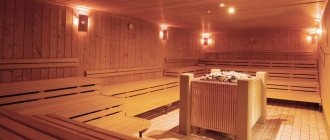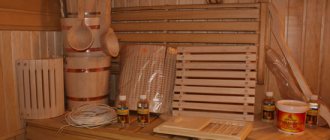The bathhouse has become a symbol of Russia, by which it is recognized throughout the world. Even centuries ago, the unusual ritual of bathing in a Russian bathhouse caused surprise among those few foreigners who traveled so far from their families. Whipping with bath brooms and swimming in an ice hole amazed their imagination. These traditional procedures were unknowingly perceived by many foreigners as religious self-flagellation. On the other hand, Russian people, who occasionally visited European countries during the Middle Ages, were surprised by the fact that the local people practically did not wash themselves at all. In ancient times, there was a misconception among European peoples: washing is harmful to health. And almost all people washed only a couple of times in their lives: after birth and before the wedding.
Meanwhile, in Rus', people loved to take a steam bath and swim, doing this with enviable regularity. Moreover, relaxation in a Russian steam room was perceived both earlier and today not only as a cleansing of the body, but also of the spirit. In different centuries, the bathhouse played an important role as a means of treating many ailments. Centuries have passed, and doctors recognize the benefits of bath procedures as an aid for a number of diseases. Let's find out in more detail where the Russian tradition of taking a steam bath comes from and what customs are associated with it.
The concept of a Russian bath, the history of its appearance
A Russian bathhouse is a specially equipped room that is designed for water hygiene and thermal procedures for the purpose of prevention and healing of the entire body.
Today it is difficult to judge what prompted ancient man to think about creating a bathhouse. Perhaps these were random drops that fell on a hot fireplace and created small clouds of steam. Perhaps this discovery was made intentionally, and the person immediately appreciated the power of steam. But the fact that the culture of steam baths has been known to mankind for a very long time is confirmed by numerous archaeological excavations and written sources.
Thus, according to the ancient Greek chronicler Herodotus, the first bathhouse appeared in the era of tribal communities.
And having visited back in the 5th century. BC. the territory of the tribes inhabiting the Northern Black Sea region, he described in detail the bathhouse, which resembled a hut-hut, with a vat installed in it, into which red-hot stones were thrown.
Flooring
Concrete, wood or clay can be used as flooring in the bathhouse. The latter material practically does not allow moisture to pass through, so water stagnant in the cracks will emit a very unpleasant odor. Wood absorbs moisture well and takes a long time to dry, which inevitably leads to decomposition of the material. That is why preference is often given to:
- Self-leveling concrete floors, the surface of which is tiled (anti-slip). You can put wooden sheathing or cork carpets on its surface so as not to walk on the cold surface.
- Clay.
- Wood.
First of all, the foundation is prepared. For this, sand is used, the layer of which is about 10 cm, after which it is thoroughly compacted. After that, the same layer of crushed stone is poured, on top of which roofing material is spread (the sheets on the walls are laid overlapping). A layer of cement screed can be applied to its surface, while maintaining a slight slope towards the previously installed drain. In the shower and steam rooms, the flooring surface is tiled. While in the dressing room and rest rooms you can lay out more comfortable wooden floors. As a basic care for such coatings, it is better to keep them dry and regularly ventilate the premises.
Unwashed Europe and clean Russia
Later sources indicate that bath culture also existed in Ancient Rome, whose rulers spread it to the conquered territories of Western Europe. However, after the fall of the Roman Empire, both the bathhouse and ablution as such were forgotten in Western Europe. There was a ban on bath culture, which was explained, among other things, by widespread deforestation and, as a consequence, a shortage of firewood. After all, in order to build a good bathhouse and heat it well, it is necessary to cut down a lot of trees. Medieval Catholic ethics also played a certain role, which taught that nudity of the body, even for washing, was sinful.
The decline in hygienic requirements led to the fact that Europe for many centuries was mired not only in its own sewage, but also in diseases. Monstrous epidemics of cholera and plague only for the period from 1347 to 1350. killed more than 25,000,000 Europeans!
Bath culture in Western European countries was completely forgotten, as evidenced by numerous written sources. Thus, according to Queen Isabella of Castile of Spain, she washed herself only twice in her life: when she was born and when she got married. An equally sad fate befell King Philip II of Spain, who died in terrible agony, consumed by scabies and gout. Scabies finally tormented and brought Pope Clement VII to the grave, while his predecessor Clement V died of dysentery, which he contracted because he never washed his hands. It is no coincidence, by the way, that dysentery began to be called “the disease of dirty hands” already in the 19th and 20th centuries .
Around the same period, Russian ambassadors regularly reported to Moscow that the king of France stank unbearably, and one of the French princesses was simply eaten by lice, which the Catholic Church called God's pearls, thereby justifying their senseless ban on baths and the culture of basic hygiene procedures.
No less curious and at the same time repulsive are the archaeological finds of medieval Europe, which today can be seen in museums around the world. Eloquently testifying to the widespread filth, stench and uncleanliness, exhibits are on display for visitors - scratchers, flea traps and saucers for crushing fleas, which were placed directly on the dining table.
Flea catcher - devices for catching and neutralizing fleas; in the old days an essential element of the wardrobe
Today it has already been proven that French perfumers invented perfumes not in order to smell better, but in order to simply hide the smell of a body unwashed for years under the fragrance of floral aromas.
Blokholovka
And all that remains is to sympathize with the daughter of Grand Duke Yaroslav the Wise , Anna , who, after marrying the French King Henry I , wrote to her father at home, saying:
Why did I anger you so much, and why do you hate me so much that you sent me to this dirty France, where I can’t even really wash myself?!
Bathhouse foundation
If we are talking about independently arranging the foundation, then it is better to give preference to a strip foundation. It is perfect for both rocky and earthen soil. The approximate height of the foundation will be no more than 65 cm. In this case, the level of the blind area should be 15 cm below the foundation itself. For other types of soil, it is recommended to fill a layer of at least 85 cm, and in some cases more. The groundwater level is also important, since the lower rooms can be used as cellars or the building itself will have more than one floor. True, then the building will look little like a bathhouse. If groundwater is located too close to the surface, it is not worth stopping construction work. It is enough to simply raise the place chosen for construction and take this into account in the physical layout.
To avoid downtime, the main work and planning should be combined. When digging a trench, the earth is thrown onto the area reserved for backfilling. Additional soil will not be needed (purchase of such), since the required volume will be found in the place reserved for the drainage pit. You can save a lot here. It is better to create an additional layer (sand cushion) from coarse sand. Its approximate height will be 15-25 cm. For timely removal of moisture, it is recommended to take care of a layer of crushed stone; it will also be useful for cushioning the foundation. The blind area is not decorative, but waterproofing. In this case, the foundation will not move even in very low temperatures and swampy areas.
But what about Rus'?
And in Russia, the bathhouse has always existed , at least according to the Byzantine historian Procopius of Caesarea , who back in the 500s. wrote that the culture of ablution accompanies the ancient Slavs throughout their lives.
According to ancient descriptions, the bathhouse was a log structure with a fireplace, on the hot coals of which water was poured from time to time, which turned into steam. According to popular beliefs, the guardian of the bathhouse and its soul is the bannik - a completely naked old man, whose body is covered with broom leaves. Bannik was supposed to be cajoled from time to time by treating him to bread and salt, which once again emphasizes the respectful attitude of the Slavs towards the bathhouse itself and its “essence”, which they literally idolized.
Appearing on the territory of Russia back in the days of paganism, when people worshiped the cult of fire and water, both the bathhouse and the home were deeply revered by the Slavs, as noted in their works by researchers of Russian life I. Zabelin and A. Afanasyev . The bathhouse was not just a place where one could cleanse one’s body of dirt and take hygienic procedures, but also a kind of medical and preventive institution where people of the ancient medical specialty could put any sick person back on his feet.
In turn, the chronicles of the X–XIII centuries. indicate the widespread use of the bathhouse among the Eastern Slavs, starting from the 5th–6th centuries, when it was affectionately called movnitsa, mov, mylnya and vlaznya. And even with the baptism of Rus', when the church began an active struggle against folk healers and all sorts of superstitions, the bathhouse did not cease to exist, but only strengthened its influence, as it became a place for mandatory visiting before performing the most important church rituals - baptism, wedding, communion and others .
The tradition of taking a steam bath in public baths
In past centuries, foreigners were quite surprised by the practice in Rus' of people of both sexes to steam in communal baths. True, this did not occur everywhere and with reservations. If we talk about Russian village baths, they were intended for visiting by one family. People of both sexes bathed in them, but only their closest relatives, and they did not allow strangers to bathe with them. According to tradition, men and children were the first to steam in the bathhouse, and after everyone else it was the women’s turn to wash.
But in large cities where the nobility lived, preference was given to large public baths, where Russian people really all steamed at the same time, without distinction between genders and ages. Such public institutions were one-story buildings erected near rivers. After having a good steam in the bathhouse, many people preferred to cool off in a pond.
The internal layout of public Russian baths was quite simple. They had only three types of premises:
- locker rooms;
- soap shops;
- paired
Empress Catherine II, who ascended the Russian throne and was of German origin, considered it unacceptable (like many of her compatriots) to wash both women and men at the same time. Therefore, in 1743, by her highest decree, she ordered to divide the baths into women's and men's premises. True, like many official decisions in Rus', this decree existed for a long time exclusively on paper, and people continued to use baths in the general manner. The division into opposite-sex halves occurred only when new steam rooms were built en masse, in which separate rooms were initially provided.
Closer to the 19th century, the bath business flourished more and more in the Russian Empire, and pretentious baths began to open everywhere in large cities. They were distinguished by rich furnishings, expensive buffets with exquisite dishes and high-quality service. Entrance to such elite establishments was expensive, which meant that there was still an opportunity to weed out inappropriate audiences, which the high-born gentlemen liked so much.
The most famous and sparkling with luxury were the Sandunovsky baths in Moscow, which were popularly nicknamed simply Sanduny.
The interiors and architecture of this building are so magnificent that in 1992 the Sandunov Baths were officially declared an architectural monument. Since then they have been under state protection. This means that no owner will be able to change their architectural appearance. Not only all Russian nobles of that time loved to relax in the luxurious surroundings of this establishment, opened in 1808, but also many foreigners who began to appreciate the bathhouse.
“Heat my bathhouse in white!”
The white bathhouse, which V. Vysotsky sings about in his song, appeared in Rus' much later than the black bathhouse, gradually displacing the latter. At first, the Slavs built baths without a chimney, in black style, and a periodically opening door was used as natural ventilation. In a black-style sauna, smoke does not go into the chimney, but into the sauna room itself, from where it exits through an open door, as well as through a special hole in the ceiling or wall (the so-called “pipe”). After the firebox is finished and the coals have completely burned out, the door is closed, the chimney is plugged, and the shelves, benches and floor are washed generously with water to remove soot and the bath is kept for about 15 minutes before use so that it dries and gains heat. Then the remaining coals are raked out, and the first steam is released so that it carries away the soot from the stones. After that you can steam. A black sauna is more difficult to heat and cannot be heated during washing (like a white sauna), but due to the fact that the smoke eats up all the previous odors, a black sauna has its own charm, unattainable in a white sauna.
Later they began to build white baths, where the source of heat and steam was a stove-heater with a chimney.
Vasily Shevchuk. "Russian baths in black style"
In addition, at that time there was another interesting and unusual way to steam directly in a Russian oven. To do this, it was carefully heated and the bottom was covered with straw. Then a person climbed inside the oven, taking with him water, beer or kvass, which he poured over the hot walls of the hearth and took a steam bath, after which he came out and doused himself with cold water. Even the weak and old people did not deny themselves such an unusual pleasure, they were simply pushed into the oven on a special board, and then a healthy person climbed in to wash and steam the weak one, as expected.
Main stages of construction
Not a single event aimed at the construction of buildings and structures can do without a high-quality and durable foundation. Its filling should be carried out based on the expected weight of the main structure and the characteristics of the site (soil). An extension is a gable or shed roof structure that can create several additional rooms on the second floor. A flat roof can help with arranging a solarium. The power of the base should not depend solely on the dimensions of the building. Any type of savings on the foundation is prohibited, because we are talking not only about the quality of the future structure, but also about the level of its safety.
A bathhouse for a Russian is more than love!
The bathhouse accompanied every Russian person from birth to death. In no other culture in the world has it become as widespread as in Rus', where visiting it was elevated to an obligatory cult and had to occur regularly.
Not a single celebration could take place without it, and when meeting even a random guest, the owner first of all invited him to visit the bathhouse, and then taste the treat and spend the night. It is no coincidence that in Russian fairy tales, in addition to shelter and dinner, travelers are always offered a bathhouse.
Hen and stag parties, as they would say today, necessarily ended with a visit to the bathhouse, and the young people themselves, having become spouses, were obliged to take it regularly, every time after marital intimacy, if they went to church the next morning. It was necessary to go to the bathhouse with almost any ailment, especially if it was a cold, runny nose, cough and joint diseases.
The therapeutic effect of this simple and pleasant procedure is comparable to the strongest effect on the entire human body. When every cell of the body receives an unimaginable charge of energy, forcing it to work in a new way, thereby restarting the natural processes of regeneration and self-renewal. And alternating high temperatures with cold, when after visiting the bathhouse it is customary to jump into the snow, an ice hole, into a river, or simply douse yourself with ice water - this is the best way to harden and strengthen the immune system.
As for the special love of Russians for the bathhouse, it is embodied not only in folklore, but also reflected in historical documents. Thus, the Russian historian and researcher of the customs and life of the Russian people N.I. Kostomarov repeatedly notes in his works that people went to the bathhouse very often in order to wash themselves, heal, and just for fun. According to him, for a Russian person, visiting a bathhouse is a natural need and a kind of ritual, which neither adults, nor children, nor the rich nor the poor can violate.
In turn, foreigners who visited Rus' were surprised to note the habit of the Russian people to wash themselves very often and for a long time, which they had not encountered either in their homeland or in other countries. In fact, as a rule, we washed once a week, on Saturdays. But for foreigners who almost never washed, it seemed “very often.” For example, the German traveler Adam Olearius once wrote that in Russia it is impossible to find a single city or even a poor village where there is no bathhouse. They are simply here at every turn, and they are visited at every opportunity, especially during periods of ill health. And as if to summarize, in his writings he noted that perhaps such a love for the bathhouse is not without practical meaning, and that is why the Russian people themselves are so strong in spirit and healthy.
As for Europe, for the revival of the custom of steaming and washing regularly, it should be grateful to Peter I and the Russian soldiers, who, terrifying the same French and Dutch, steamed in a hastily built bathhouse, and then jumped into the icy water, despite to the frost that reigned outside. And the order given in 1718 by Peter I to build a bathhouse on the banks of the Seine completely horrified Parisians, and the construction process itself attracted onlookers from all corners of Paris.
Steam room device
Even when you have just conceived a bathhouse project, the steam room device will immediately begin to determine the position of ventilation, water supply, electrics and much more. This is partly due to the material from which the bathhouse will be built, partly not.
For now, let's look at what is determined by the material .
In a wooden bath
A wooden bathhouse is either a log house or timber. When it comes to installing a steam room in a wooden bathhouse, the main question is to leave it as is, cover it with clapboard without insulation and foil, or with them.
ATTENTION! You must know what kind of wood your log house or timber is made of. If it was used with coniferous species, then the lack of sheathing will lead to a constant release of resin on the walls.
Resin leaks
Therefore, is still coniferous with clapboard. If deciduous logs were used for the bathhouse, then there is no need to sheath it, but care must be taken to ensure that the seal between the logs does not get wet during the procedures. In principle, you can use a sealant if the manufacturer guarantees its safety at high temperatures.
If you decide to sheathe it so as not to get dirty with resin, then you should choose lining made from aspen, linden and other hardwoods . of vapor barrier should be placed between the clapboard and the logs to prevent the logs from getting wet.
Insulation in a wooden bathhouse will not hurt where there is severe frost in winter. Still, fuel is saved and you are more comfortable. But the debate about foil in the steam room never stops. We will not convince or change anyone’s mind , we’ll just say that for insulation you will need a lathing, on it - 10-15 cm of insulation for a sauna, foil, a ventilation gap with the help of a lathing and everything is covered with clapboard. Details here.
In a bath made of aerated concrete
Block baths are all hygroscopic to one degree or another , which means there is a greater or lesser need to protect them from moisture absorption. Installing a steam room in a bathhouse made of aerated concrete will definitely require you, first of all, to waterproof this very aerated concrete so that liquid does not accumulate in it, and it does not lose its thermal insulation properties and does not collapse.
Due to the fact that most block materials are quite fragile, insulation should not be done with support from the walls . The lathing must be attached to the floor and ceiling, and the thermal insulation material must be attached to the lathing itself. Then there will be no load on the walls. You can learn more about the insulation of block baths here.
In a brick bath
The pattern of the pie is always the same , and brick can be classified as a block material. Of course, a steam room in a Russian brick bath necessarily requires insulation and lining with clapboard.
There are several different methods for insulating brick walls, all of which are described in detail in this article.
In frame
Frame buildings are already insulation in almost its pure form. It is inserted into the openings of a wooden frame and covered with wooden panels. Is it necessary to additionally insulate it when installing a steam room in a bathhouse of this type?
You will be surprised, but yes, it is necessary. A sheathing is made on the frame wall, a layer of insulation is inserted into it, everything is covered with a vapor barrier, another lath and clapboard. However, if you are interested, read the article about insulating the walls of a frame bath.
Bathhouse with a pond. What will replace the pond?
You are lucky - there is a pond or lake near your house. The bathhouse will turn out to be originally Russian. Equip approaches to a cold spring and alternate the steam room with diving into cool water. Don't be upset for those who don't have a pond. Organize a swimming pool on your site in the summer, and in winter replace it with white snow, of which there is plenty in Russia. Some may allow a swimming pool in the bathhouse all year round.
Having examined the internal structure of the building, you can draw up your own project for a health complex. How to arrange a Russian bathhouse on your property is up to you to decide after mastering the information presented in the article. Let your bathhouse be the best, the most Russian.
Interior decoration and decoration
The wood used to decorate the bathhouse can only be covered with drying oil or stain. The use of varnish is prohibited. All areas with which a person will come into contact must be as even and smooth as possible. All metal elements must be hidden in wooden boxes; if necessary, they are also galvanized. For this, it is recommended to use brass or bronze, since they are less susceptible to corrosion than others. Too bright lighting will be difficult for tired eyes to perceive. You can be creative when choosing lamps, using antique ceiling, corner or wall options. The only limitation is that they all must be moisture-resistant and heat-resistant.
Roof of the bathhouse
Even at the design stage of a Russian bathhouse, you should decide on the type of roof that is planned. There are only a few options:
- roofless;
- attics.
Designs that include an attic space will look more presentable, and they will initially have a higher level of thermal insulation. They are very convenient to use in winter, while roofless ones are recommended to be installed in summer cottages, which are visited exclusively during warm periods of the year. You can always place a water tank in the attic, which will free up a lot of space on the ground floor. Most roof elements are load-bearing parts of the main structure (purlins, rafters). Roofing includes waterproofing and sheathing.
Floor beams will be laid on the top row of walls, fixed exclusively in a horizontal position. Rafters are installed on their surface, which are logs whose diameter is at least 12 cm. If beams are used, their cross-section should be equal to or greater than 65 cm. Metal brackets and ridge beams are used as fastening for the rafters (as a retainer between them ). Next, the installation of solid wooden flooring or sheathing is carried out. And only after this can you begin work aimed at installing the ceiling.
Otherworldly inhabitants of the bathhouse and ancient customs
The steam room was used not only to cleanse the body and soul, it was believed that evil spirits lived here. It’s probably not for nothing that such an opinion exists. After all, even today, a person who is too annoying is sent to the bathhouse. The Slavs believed that a bannik and his family lived in the room.
They tried to appease the inhabitant of the steam room by any means. After the construction of the premises, a black chicken carcass was buried under the threshold. This was a kind of gift to the bannik. When actively using the steam room, the owner, having heated the bathhouse, before crossing the threshold, asked permission from the spirit. You had to have some food with you.
When leaving the steam room, you had to say “thank you” to the bathhouse for the good steam. All things that were used in the “movna” were prohibited from being brought into the living quarters. Also, you cannot hang icons on the walls in the bathhouse. Before entering the steam room, you had to remove your cross. Return to contents
Types and types of brooms
- Birch broom is the most popular and famous broom, which has anti-inflammatory and disinfecting properties. Birch broom is especially useful for heavy smokers, because it helps remove toxins and waste from the lungs.
- An oak broom is useful for people with oily skin. Oak leaves contain tannins, which dry out the skin, removing its top oily layer. An oak broom helps normalize blood pressure and eliminates excessive sweating.
- Linden broom is useful for colds and inflammatory diseases. Linden leaves contain substances that can normalize sleep and improve skin condition.
- Bird cherry broom. The leaves of this broom contain a substance that promotes the healing of minor abrasions and wounds. A steamed bird cherry broom spreads a pleasant and healing aroma into the steam room. This option is especially popular with women who combine a visit to the steam room with an aromatherapy procedure.
- Walnut broom is recommended for use by people suffering from diabetes.
- Juniper broom has a positive effect on the nervous system and normalizes the emotional state.
- A fir broom removes waste and toxins from the body and reduces swelling of the face and legs. It also relieves an attack of radiculitis well and relieves insomnia.
- Eucalyptus broom cures colds and eliminates allergies.
When going to the bathhouse, in addition to a broom, you should take with you the following items:
- Terry robe and towel.
- Rubber flip-flops.
- Felt hat.
- A hard mitten and a washcloth.
- Clean sheets and linen.
- Drinks include herbal teas, still drinking water, and kvass.
You can order the finishing of a Russian bath or Finnish sauna on our website or by calling: 8 (499) 110-97-56.
Orthodox Church and bathhouse
The clergy at the beginning of the second millennium had different attitudes towards “Movna”. Catholics categorically did not accept such a tradition. But medieval Orthodoxy had a positive attitude towards the steam room. In the Kiev-Pechersk Monastery, taking bath procedures was considered a mandatory element of treatment. Patients in the hospital at the temple visited the steam room twice a month.











